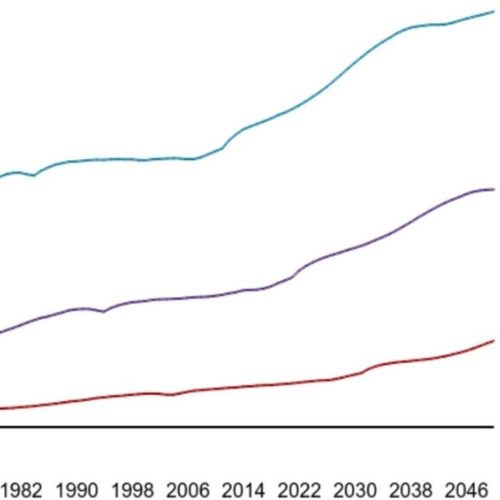In our modern world, advancements in healthcare have significantly increased life expectancy. However, this has also led to a higher prevalence of multiple chronic diseases, or multimorbidity, among older adults. The study "Association of Lifestyles and Multimorbidity with Mortality among Individuals Aged 60 Years or Older" explores the impact of healthy lifestyles on all-cause mortality among this population. This article delves into the findings of the study and highlights the importance of adopting healthy habits to improve longevity and quality of life.
What is multimorbidity?
Multimorbidity is a term used to describe the occurrence of two or more chronic health conditions in a single individual. This situation is especially common among older adults and can significantly affect their quality of life and overall health.
Common chronic conditions
The chronic conditions that frequently contribute to multimorbidity include:
- Hypertension (High Blood Pressure): A condition where the force of the blood against the artery walls is too high, which can lead to heart diseases and strokes.
- Diabetes: A disease that occurs when blood glucose (blood sugar) is too high, affecting the body's ability to produce or respond to insulin.
- Cardiovascular Diseases (CVDs): A group of disorders of the heart and blood vessels, including coronary artery disease, heart attack, and stroke.
- Chronic Obstructive Pulmonary Disease (COPD): A chronic inflammatory lung disease that obstructs airflow from the lungs, making it difficult to breathe.
- Cancers: A variety of diseases characterized by the uncontrolled growth and spread of abnormal cells.
Prevalence of multimorbidity
Older adults, particularly those aged 80 and above, are more susceptible to developing multiple chronic conditions simultaneously. The reasons for this increased prevalence include:
- Aging Process: As people age, their bodies undergo various physiological changes that make them more vulnerable to chronic diseases.
- Accumulation of Risk Factors: Over a lifetime, individuals accumulate various risk factors such as poor diet, lack of exercise, and exposure to harmful substances, which contribute to the development of chronic conditions.
- Extended Life Expectancy: Advances in healthcare have increased life expectancy, but longer life spans also mean more years at risk for developing chronic diseases.
The presence of multiple chronic conditions can lead to physical and cognitive impairments, reducing an individual's ability to perform daily activities independently.
Sadly, the risk of death increases with the number of chronic conditions an individual has. This is due to the compounded effects of multiple diseases on vital organs and systems.
Impact of multimorbidity
The study analyzed data from two extensive cohort studies: the Chinese Longitudinal Healthy Longevity Survey (CLHLS) and the UK Biobank. The primary objective was to examine the impact of adopting a healthy lifestyle on the risk of all-cause mortality among older adults, both those with multimorbidity and those without it.
Chinese Longitudinal Healthy Longevity Survey (CLHLS)
The CLHLS is a prospective cohort study focusing on the Chinese population aged 60 years and older. It includes participants from various regions across China. The study collects comprehensive data on participants' health status, lifestyles, medical history, and physical measurements over multiple waves, starting from 1998. The data provides insights into the long-term health outcomes of older adults in China.
UK Biobank
The UK Biobank is another large-scale prospective cohort study that includes participants aged between 38 and 73 years from across the UK. The study gathers detailed information through questionnaires, interviews, physical measurements, and biological samples. The UK Biobank tracks participants' health outcomes over an extended period, linking the data with hospital admissions, cancer registries, and death records.
Key statistics
Participants: 29,451 from CLHLS and 173,503 from UK Biobank.
Follow-up Period: 4.7 years in CLHLS and 12.14 years in UK Biobank.
Deaths Recorded: 21,540 in CLHLS and 20,720 in UK Biobank.
Healthy lifestyles and mortality
The study categorized lifestyles into three groups: healthy, moderate, and unhealthy. Five key lifestyle factors were assessed: physical activity, dietary patterns, body mass index (BMI), smoking, and alcohol consumption. The findings revealed that adhering to a healthy lifestyle significantly reduced mortality risk, regardless of the presence of multimorbidity.
Impact of Lifestyle Factors
- Physical Activity: Regular exercise was associated with a 4%–51% lower risk of mortality.
- Dietary Patterns: A healthy diet reduced mortality risk by up to 41%.
- BMI: Maintaining a normal or slightly overweight BMI was beneficial, while underweight individuals had higher mortality risks.
- Smoking: Never smoking or quitting smoking significantly lowered mortality risk.
- Alcohol Consumption: Moderate alcohol consumption was preferable; excessive intake increased mortality risk.
Cultural and geographic differences
The study highlighted differences between Chinese and UK populations. For example, a higher proportion of CLHLS participants followed an unhealthy lifestyle compared to UK Biobank participants. These variations may be due to cultural, social, and economic differences between the two countries.
Common conditions and lifestyle adherence
- Hypertension: Most prevalent condition in both cohorts.
- Diabetes and CVDs: Significant contributors to multimorbidity.
- Lifestyle Adherence: Participants with multiple conditions often adhered to healthier lifestyles in CLHLS, whereas those in the UK Biobank with multimorbidity had a higher proportion of unhealthy lifestyles.
Reducing Mortality Risk with a Healthy Lifestyle
The study found that adopting a healthy lifestyle could mitigate the mortality risks associated with multiple chronic conditions. This was true for both the CLHLS and UK Biobank cohorts. For instance, participants with three or more conditions who followed a healthy lifestyle had a significantly lower mortality risk compared to those with unhealthy lifestyles.
- Healthy lifestyle benefits: Reduced mortality risk by 27%–41% in CLHLS and 22%–42% in UK Biobank.
- Moderate lifestyle benefits: Lowered mortality risk by 11%–27% in both cohorts.
Practical tips
Given the study's findings, it is evident that even small lifestyle changes can have a profound impact on the longevity and quality of life for older adults, particularly those with multimorbidity. Here are practical steps to embrace a healthier lifestyle:
- Increase physical activity: Engage in regular exercise such as walking, swimming, or yoga.
- Adopt a balanced diet: Incorporate more fruits, vegetables, whole grains, and lean proteins into daily meals.
- Maintain a healthy weight: Aim for a BMI within the normal or slightly overweight range.
- Quit smoking: Seek support to stop smoking and avoid exposure to secondhand smoke.
- Moderate alcohol intake: Limit alcohol consumption to moderate levels.
The association between healthy lifestyles and reduced mortality risk underscores the importance of lifestyle interventions for older adults.
By making conscious choices to improve physical activity, diet, weight management, and avoiding harmful habits like smoking and excessive drinking, older adults can significantly enhance their longevity and overall well-being.
This study serves as a crucial reminder that it's never too late to adopt healthier habits and improve quality of life, regardless of the number of chronic conditions one may have.
The study was carried out by Dan Liu and team fro Jinan University and published in SSM, Population Health.







